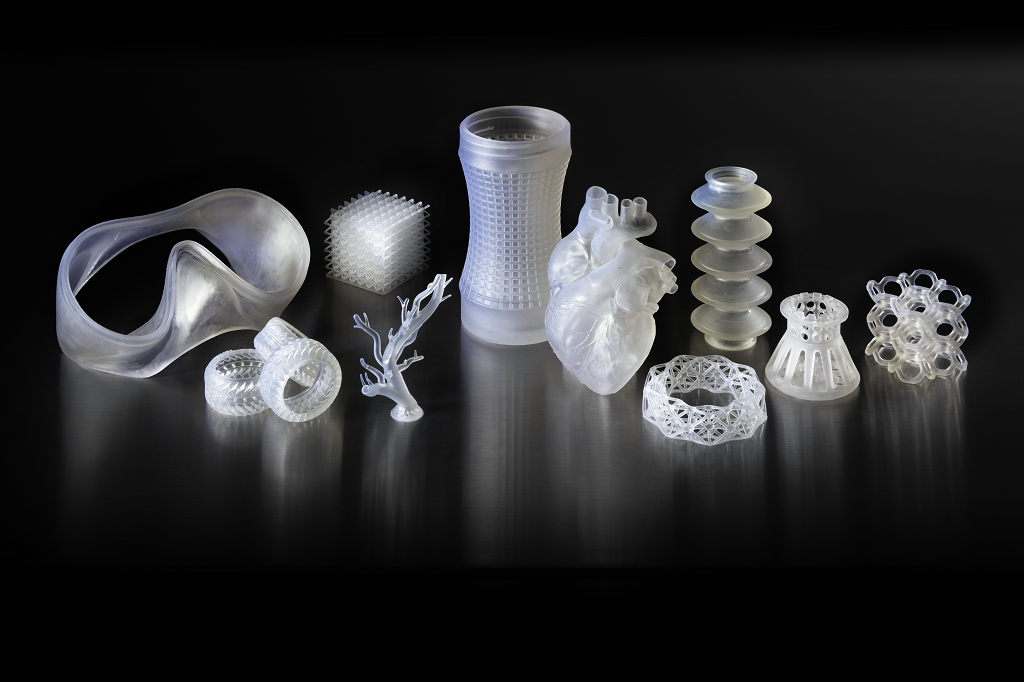![3D printed parts made with Elastic Resin [Image: Formlabs]](https://fabbaloo.com/wp-content/uploads/2020/05/FormlabsElasticResinprintedparts_img_5eb09f3fa77f4.png)
Formlabs is introducing two new resins this week at CES while showcasing end-to-end workflow with 3D printing.
There will be plenty of 3D printing at CES this year, but it may not always be so obvious as in years past when rockstars came to big-name 3D printer manufacturers’ booths to talk up consumer usage. In 2019, we know that 3D printing isn’t for everyone…but that doesn’t mean it’s not for everything. The technology is still featuring in Vegas, but without trumped-up promises of it being a consumer tech that will become as ubiquitous as the microwave. It’s now about what’s been 3D printed. And Formlabs is well aware of who they’re talking to at a show featuring consumer electronics.
“Of the more than 4,000 CES exhibitors, 3D printing was likely part of the ideation, development or manufacturing for more than 90% of them. 3D printing continues to be one of the most important tools for anyone making anything. Time and time again we hear about the importance of seeing a product or project physically vs. digitally, which is why this year we’re showing workflows from end-to-end,” said Formlabs Co-Founder and CEO Max Lobovsky.
3D printing itself still has a presence at the large show, albeit significantly smaller than in years past. Messaging has matured, being directed now not to the consumer but to the consumer product manufacturer.
“Whether you’re creating a creature, or introducing personalization to your product line, it helps to bring that process to life for an audience at CES,” Lobovsky said.
Choosing the show as a launch pad for the latest expansion of its materials library, Formlabs is introducing Elastic Resin and Digital Dentures resins.
Elastic Resin, designed to be the most pliable Engineering Resin for the Form 2, offers a Shore durometer of 50A with high elongation and a look and feel said to be comparable to a molded silicone part. Elastomeric materials are beneficial in uses that need certain flexibility: medical models, robotics, wearables, and more that most frequently are made with molds. The new material has its own new set of printing parameters (e.g., denser support structures), and Formlabs recommends that users read their material-specific support article before use.
Early users of Elastic Resin include Cycling Sports Group and Boston Children’s Hospital.
“We had been looking for a softer material with higher elongation for prototyping of grips and frame protection pieces,” said Engineering Manager, Research Jeremy Mikesell of Cycling Sports Group. “Until now we were urethane casting these soft parts in 3D printed molds. The parts we have printed in Elastic Resin simulate 50-60A TPU very well. Printing these parts directly will be a big cost and time saver. Elastic Resin is a great addition to our material library.”
![Digital Dentures production in process [Image: Formlabs]](https://fabbaloo.com/wp-content/uploads/2020/05/FormlabsForm2printingDigitalDentures_img_5eb09f404c153.jpg)
Formlabs is also now shipping Digital Dentures, which the company describes as an “accessible direct 3D printed dental prosthetic.” Comprising Denture Base Resin and Denture Teeth Resin, the Digital Denture solution allows for a simplified workflow in creating dentures — fully 3D printed, accurate dentures. The teeth and gingiva (gums) are 3D printed separately and brought together during post-processing, Formlabs explains. Digital dentistry is in focus for much of the 3D printing industry today, and Formlabs’ solution is designed to be efficient, scalable, and intuitive. These offerings are currently available only in the US, where they are certified biocompatible and ready for long-term in-mouth use; the company is planning to expand global availability.
In addition to the new materials, Formlabs is looking at the bigger picture for workflow.
![Gillette Razor Maker handles being 3D printed on a Form 2 [Image: Formlabs]](https://fabbaloo.com/wp-content/uploads/2020/05/FormlabsGilletteRazorMaker28129_img_5eb09f40d2c55.png)
In October, the company introduced a partnership with Gillette to create full or partially 3D printed razor handles. The Razor Maker platform, available to US customers, allows users to choose from 48 detailed designs, customized with color choice and some text, 3D printed with Formlabs’ SLA systems. The company is featuring the razors at CES to highlight mass customization as an achievable, on-the-market solution; other exhibitors, take note.
Dávid Lakatos, Formlabs’ Chief Product Officer, said, “Mass customization with 3D printing is finally becoming a reality for consumers to experience end-use printed products. Historically, 3D printing has been involved in the development or manufacturing processes for most products people interact with every day, but consumers have had little interaction with 3D printing itself. We’re thrilled to be partnering with Gillette. These new custom razor handles are the next step towards changing that dynamic and getting 3D-printed products directly into the hands of consumers.”
![3D printed prototypes of Aiman Akhart’s Fungisaurs [Image: Formlabs]](https://fabbaloo.com/wp-content/uploads/2020/05/Fungisaurs3Dprintprototype_img_5eb09f417e7bb.jpg)
Finally, the Formlabs booth experience includes live demos showing a monstrous use of 3D printing. That is, creating monsters. And creatures. And other fantastic elements. “Leading industry creature designers showcasing their creative workflow from scan-to-sculpt-to-print,” the Formlabs team is featuring Aiman Akhart, Daniel De Leon, Jared Krichevsky, and Kyle Brown.
It’s not just about the 3D printers at CES, it’s about what they can do.
That said, Formlabs is also displaying a 40-plus print farm of working Form 2 machines throughout the week. At CES this week? Find Formlabs at LVCC, South Hall, Upper Level, Booth #31517.
Via Formlabs











Formlabs just issued three new videos for beginners to 3D printing, and the result was quite surprising.